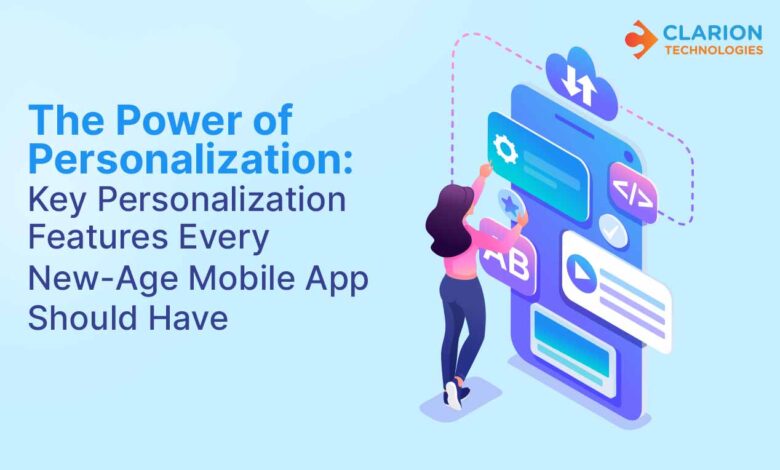
Imagine this—You open a shopping app to buy a pair of sneakers. An eternity later, you’re still scrolling, swamped with too many alternatives that don’t matter—sizes that don’t fit, and companies you’ve never heard of. Does this scenario ring a bell?
In a time where there are a lot of digital experiences, people aren’t overwhelmed by not having enough options; they’re overwhelmed by having too many of the incorrect ones. People don’t seek experiences that fit everyone anymore. They live in a world where everything is connected, easy to use, and getting more and more personalized with the help of AI solutions. They want all their latest mobile apps to be the same way.
Personalization is no longer a nice-to-have; it’s a must-have. People want streaming apps that automatically recognize what kinds of music they like, shopping sites that suggest items that fit their style, and fitness programs that change to fit their goals. Personalization is becoming the most important thing for keeping users interested and happy. The greatest mobile apps use it to interact with users on a deeper level and to boost retention, satisfaction, and income.
In this blog, we’ll talk about why customization is more important than ever, how it affects how people use things, and the most important personalization features that every modern mobile app should have to be relevant and competitive.
Why Personalization Matters
Successful and best mobile application development companies in 2025 will focus on personalization, AI integration, and smooth user experiences. They will have features like voice control, compatibility with several platforms, and strong security measures. Clarion Technologies’ Agentic AI solutions are designed to achieve such unique business use cases.
The global market for mobile apps is expected to increase at a rate of 14.33% per year from 2025 to 2034, reaching $1.103 trillion by 2034.
- Enhanced user engagement
Personalization makes things feel more relevant. Users are more likely to use the app when they receive content or suggestions based on their interests. This engagement leads to longer sessions, more app openings, and better retention rates.
- Increased user satisfaction
Users are inundated with options. Personalization makes their experience easier by showing them material, goods, or services that are in line with their interests. This not only makes people happier, but it also makes their brains work less and makes them less tired of making decisions.
- More conversions
People are more likely to do what you want them to do when they have personalized experiences. Personalized suggestions based on what a user does, like buying something, viewing a video, or joining up for a service, are much more powerful than general calls to action.
- Competitive advantage
In crowded app stores, it’s important to stand out. Apps can stand out by offering value that competitors might not, thanks to personalization. It also builds brand loyalty and gets others to talk about your business. Clarion’s Agentic AI experts can help you build apps that outshine competitor apps.
Core Principles Behind Personalization
Before getting into the details, it’s important to know the basic ideas behind good personalization:
- Consumer-focused design: Make sure that the experience is based on what the user wants and needs.
- Data-driven decisions: Use data about behavior, demographics, and the situation to help you personalize.
- Information integrity and visibility: Be open and honest about what data you collect and how you utilize it. Give people ways to control things and agree to them.
- Ongoing optimization: Personalization is not something you can do once and forget about. It has to change based on fresh information and what users say.
- Dedicated team: Collaborate with top mobile app development experts and remote AI developers to create apps that deliver hyper-personalized user experiences.
Key Personalization Features Every New-Age Mobile App Should Have
- User onboarding personalization
Onboarding is a crucial part of the user journey. Personalized onboarding makes sure that consumers feel like they are being noticed and understood from the start.
- Adaptive walkthroughs: Show different onboarding screens depending on the type of user (for example, first-time users or returning users).
- Custom goals and preferences: Allow users to create goals or choose preferences during onboarding to make their experience unique from the start.
- Dynamic content recommendations
News, media, e-commerce, and social apps significantly rely on personalization.
- Suggestions based on past behavior: Provide suggestions for material depending on what the user has done before.
- Collaborative filtering: Find fresh material by looking at patterns in the behavior of comparable users.
- Popular and tailored: Mix popular information with tailored suggestions to make your feed more balanced.
- Customizing push notifications
People typically ignore or even uninstall generic push alerts. Customized push notifications attract more clicks and encourage more user interaction.
- Behavioral triggers: Send alerts upon realizing user action. For instance, the user not completing their shopping or leaving their shopping cart.
- Alerts at the correct times: Send messages to users when they are most likely to respond based on activities that they have indulged on the app in the past.
- Personalization of content: Alter the message content to match the choices or actions of the user.
- Personalized in-app messaging
In-app messages give you helpful hints that improve the experience without becoming annoying.
- Contextual reminders: Offer users advice or features based on their app usage.
- Milestone merriments: Send tailored messages to users to celebrate their accomplishments/choices, like “Yippee! You are selecting the Ronaldo’s favorite show design.”
- Personalizing the user profile
Allowing users to change their profiles gives them a greater sense of ownership and makes personalization more accurate.
- Theme and layout options: Allow users choose from various UI themes, layouts, or font sizes.
- Interest tags and preferences: Make your suggestions more impactful by empowering users to choose their interests and preferences.
- Personalization based on location
Apps that assist with travel, delivery, or local service discovery greatly benefit from this feature.
- Localized content: An app user in California will really not be interested in the current traffic condition near Nevada. Show content or deals based on the user current location.
- Geofencing triggers: Send alerts when a user exits or enters a certain area. For instance, “Hey! You are only a kilometer away from your favorite shopping destination. Drop by for a discount!”
- AI-Powered search and recommendations
A smart, tailored search bar may make things a lot easier to find.
- Context-aware search: Rather than relying solely on past behavior, AI can factor in current context—such as time of day, user location, or even current activity within the app—to surface the most relevant results. For example, a food delivery app might show lunch specials at noon and dinner deals in the evening.
- Semantic understanding: AI-powered search knows what people want when they type in a search term, not just the words themselves. It can link terms like “something spicy” to real product categories, like Mexican or Thai food, or figure out what “that thriller movie from last season” means in streaming apps.
- Continuity across devices
People today utilize apps on more than one device. It is important that phone, tablet, and web experiences are all the same.
- Activity syncing: Resume sessions or content on different devices without any problems.
- Unified personalization: Keep your personalization settings the same on all platforms.
- Personalized rewards and loyalty programs
Tailoring reward systems to each individual can enhance their effectiveness and encourage participation.
- Rewards based on behavior: Offer dynamic incentives to users based on their engagement with your app. Here are a few scenarios—a fitness app might offer rewards to users who walk a certain number of steps in a week or a shopping app could unlock special offers upon referring a few friends.
- Customized challenges or milestones: Challenging and/or inspiring users with goal-driven achievements is a great way to bring back users to the app.
- Personal assistants that use voice and pictures
With voice-enabled capabilities, users can move around apps, make preferences, and finish tasks without having to touch the screen. But the actual strength is in contextual intelligence. For example, a finance app would let users ask things like, “How much did I spend on groceries this month?” based on their past expenditures.
Best Ways to Make Personalization Work
- Start by gathering data, but be ethical.
- Use analytics to learn how users act.
- Make sure that collecting data complies with GDPR, CCPA, and other privacy laws.
- Give people the choice to opt in or out easily.
- Strike a balance between automation and the human touch. AI can scale personalization, but some things, like customer service, are better with people.
- A/B test everything: Keep trying out new ways to personalize your content to see what works best for your audience.
- Don’t make it too personal: There’s a thin line between helpful and creepy. Avoid giving users the impression that you are monitoring them.
- Focus on long-term personalization: Personalize for the long term by building dynamic user profiles. Remember—users’ preferences can and do change.
The Future of Mobile App Personalization
Personalization is evolving. It has successfully transitioned from proactive to reactive and now generative. With enhancement in technologies each day and the invent of newer technologies—generative AI, edge computing, and real-time data processing—fundamentally altering the way apps communicate with individual users.
Soon, you can expect smartphone apps that:
- Change their user interfaces in real time based on the situation and user interactions.
- Use emotion detection to adjust the tone, graphics, or way of interacting.
- Make personalized content—text, video, or audio—on the fly, based on a user’s mood, habits, and tastes.
This isn’t just a look into the future; it’s a call to action. The apps that will win tomorrow are already built with personalization today.
Last Thoughts: Use Personalization to Get Ahead of Your Competitors
Personalization is a strategic necessity. In an already saturated online market, offering everyone a generic experience won’t work.
Whether you are a budding business releasing your MVP or a full-scale business foraging digital experiences, embedding unique personalization is the smartest thing you can do right now. It increases engagement, reduces turnover, and promotes loyalty, all of which are undoubtedly crucial for sustainable growth.
Clarion, one of the best mobile application development firms, can help brands turn personalization into performance. Our teams employ cutting-edge mobile app technologies to make smart, accessible, and future-proof solutions, from Java mobile application development to scalable cross-platform mobile app development.
The time is now. Get to know your users. Speak to them in their own words. Make apps that not only work, but also connect, convert, and last.
Get in touch with our experts today and future-proof your app experience.





